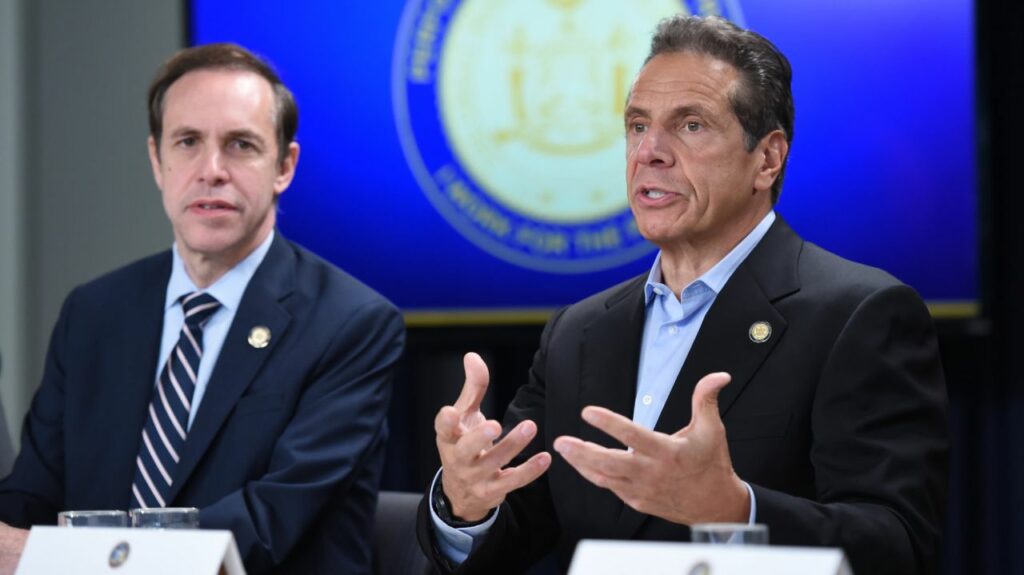Democratic and Republican state lawmakers grilled New York’s top health official Monday about the steep, though ultimately unknown death toll at the state’s nursing homes amid the coronavirus pandemic.
Members of the Democratic-led Legislature are holding hearings geared at understanding why and how the pandemic took root in New York nursing homes. Lawmakers, who plan to hold another hearing next Monday, said they want to pass better policies to protect nursing home residents and staffers if infections surge again.
The state Department of Health reports nearly 6,600 residents died at New York’s nursing homes and adult-facilities, including 6,400 nursing home residents. The state has not disclosed how many nursing home residents died at hospitals, or how many residents have been infected with COVID-19.
A June report found that at least a quarter of the COVID-19 deaths in the United States were among nursing home residents.
Gov. Andrew Cuomo promised March 2 that his administration would take a “special effort” to protect nursing homes, and later described the spread of COVID-19 through nursing homes as “fire through dry grass.”
“It’s now up to the Legislature to determine who lit the match and figure out why and how the fire fanned out,” said State Sen. James Skoufis, chairman of the Committee on Investigations and Government Operations.
State Health Commissioner Howard Zucker defended the administration’s response Monday and said officials were worried about projections from global and federal public health experts that New York could have faced a surge of over 100,000 COVID-19 patients at once. He defended his agency’s recent report, which has been panned by academics, claiming that the original March 25 directive was not a “significant factor” in virus outbreaks.
But as the number of infections have plunged and plateaued in recent weeks in New York, lawmakers grew frustrated Monday as Zucker declined to provide key data points sought by Democrats and Republicans, including a rough estimate of how many nursing home residents have died in hospitals of COVID-19.
“I will not provide information that I have not ensured is absolutely accurate,” Zucker said. “This is too big an issue and it’s too serious an issue.”
Since March, Cuomo and his administration have been tight-lipped about the extent of deaths and infections among residents of the state’s 613 nursing homes, and the governor’s declined to admit any missteps. The state stopped releasing the total number of confirmed cases at nursing homes in mid-April, and didn’t release the number of deaths at individual nursing homes until early May.
At an April 12 press conference, Cuomo said that New York hadn’t seen a “significant uptick” in deaths at nursing homes. He said health officials had responded to “little clusters.”
His administration now acknowledges deaths at nursing homes peaked April 8.
The governor has used recent press conferences and national media appearances to dismiss any questions about the state’s virus response at nursing homes as Republican-driven “politics” and lament the lack of a European travel ban until March 13.
New York gave hospitals and nursing homes sweeping protection from lawsuits under a provision that hospital lobbyists said they drafted. And on March 25, the state prevented nursing homes from denying the admission of individuals who tested positive for COVID-19 or requiring patients to be tested. The Department of Health eventually required nursing homes to regularly test staffers, and reversed course on the March 25 directive to now ban hospitals from sending COVID-19 patients to nursing homes.
Leaders of nursing homes Monday said they struggled to find enough workers early on and were left competing in March against Cuomo’s administration and other hospitals for personal protective gear. The Department of Health last month disclosed roughly 20,000 nursing home staffers were infected from late February through April alone.
Several lawmakers asked Monday if New York needs to act to help nursing homes that have long faced complaints of inadequate staffing and poor infection control. The state Department of Health has failed for weeks to tell The Associated Press how much personal protective gear, including masks, was provided by the state to nursing homes in March.
Nursing home “facilities have been kind of an afterthought and it’s time for them to be a priority,” said Republican Sen. Sue Serino.
Zucker and Cuomo aide Gareth Rhodes claimed New York is providing more COVID-19 data than other states. “Once there is a a full picture on the table, hopefully once this crisis is over, there will be many lessons learned,” Rhodes said.
But lawmakers said the lack of transparency makes it hard to protect nursing homes during the crisis. They questioned why states like California are providing the kind of data sought by lawmakers and the public.
“It seems that what y’all are doing is just trying to minimize,” said Sen. Gustavo Rivera, Democrat and chair of the Committee on Health.
(AP)












5 Responses
Hmm, Cuomo the murderer.
Life in jail, injection, 12 months in a nursing home, or Dejercio’s law, free with no bond to do more.
WHICH WOULD YOU PICK?
the full name is andrew evil eyes cuomo
Cuomo has been tight lipped ??? HOGWASH!!! That snivelling coward wasted no time blaming President Trump!!!
If Cuomo lit the match and he poured the gasoline onto the fire that went through the nursing homes in New York. He should be prosecuted for criminal negligent homicide.
Cuomo should be locked in a nursing home with no right to sue. The nursing home being “protected” from lawsuits by his executive powers.